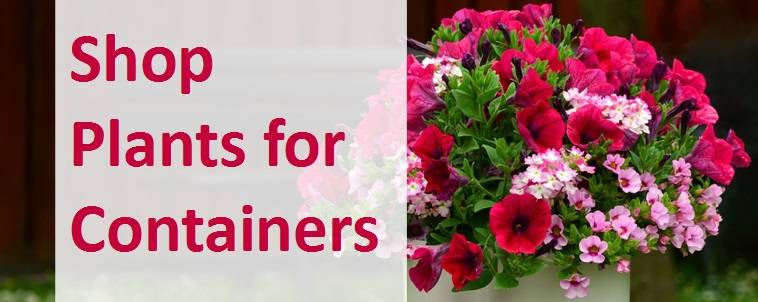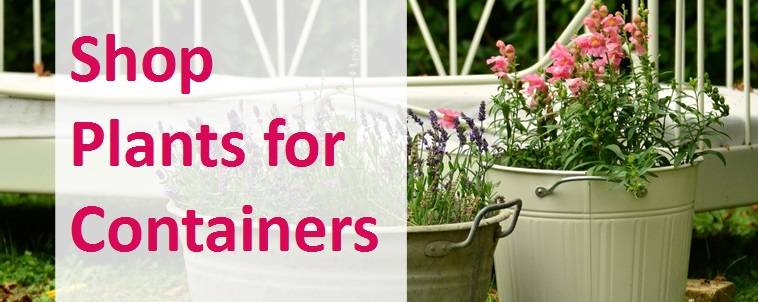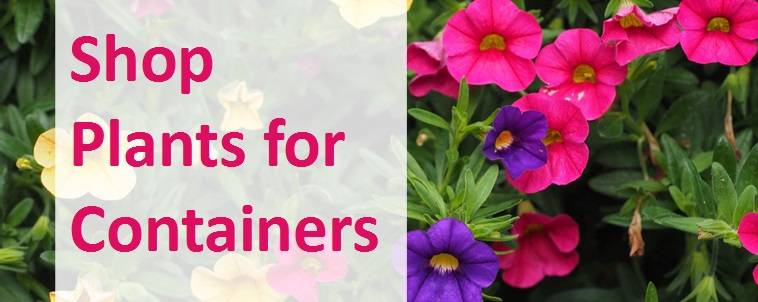Check Here Before Buying – Pot Size Matters...Not all websites offer the same. Plants in a 2-litre pot have twice the root system of a P9 or 1 litre pot.
Plants for Pots and Containers
If space is a premium, then container gardening is the answer for you. Containers and pots help utilise any available space in your garden, including hanging baskets and wall troughs to brighten up above the ground. Although most plants are suitable for growing in containers, some are especially happy in containers as they allow them to flourish without having to compete for nutrients and water from nearby shrubs and trees. Containers are also excellent for using throughout the seasons, ensuring you always have a colourful display. Planters full of Spring bulbs can be replaced with luscious summer flowering containers and then autumn/winter foliage and berries. If you plan ahead, you can even have all the seasons catered for in one container, as long as it is large enough!
If you have a greenhouse, then plant your less hardy plants into containers as this means they can be brought it for the winter, preventing them from being frost damaged and prolonging the displays in your garden.
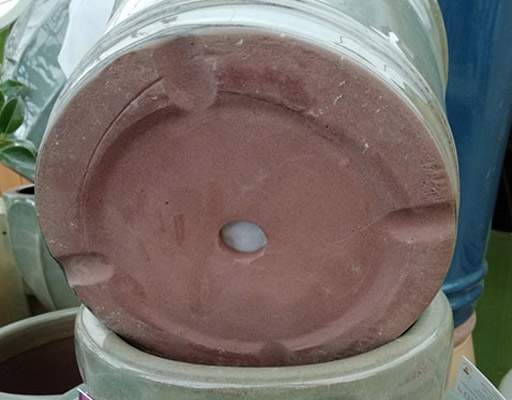
Drainage holes, such as the one above, are required in all containers and pots
When it comes to choosing a container, drainage is key. Ensure there are sufficient drainage holes in the base and consider the type of soil your plants require (dry, well-drained, boggy etc). Always check what the eventual height, spread and vigour of the plants are – you don’t want your new shrub outgrowing its container before you’ve had a chance to enjoy it. As a general rule of thumb, always go for the biggest you can afford. This allows the plants plenty of room to spread their roots, plus bigger pots retain water better than smaller ones. If after a few seasons it is still looking a little sparse, Spring bulbs or clump-forming perennials can help fill any gaps you have.
The type of container is also an important factor. Although terracotta and clay pots are much more appealing to look at than plastic ones, they are heavier and often porous, so water will evaporate through the sides too. Consider lining terracotta and clay pots with plastic ones, which are much easier to move around and to re-pot as necessary. Plastic pots are much lighter, making them more suited for decking and balconies, as this often means they are being moved around more frequently. Wooden planters are an excellent alternative to plastic or terracotta, they often blend in better too in more natural environments. However, they are prone to rotting and looking ‘shabby’ quicker, so bear in mind that they may need replacing more frequently if this is not the look you are wanting to achieve.
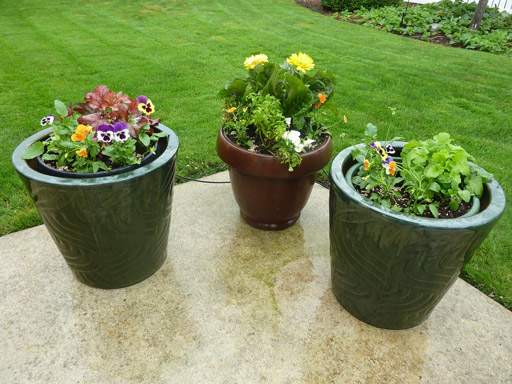
An arrangement of clay pots using plastic pots as liners
Due to their versatility, a huge range of plants can be grown in containers. If you are looking to make an arrangement in a container rather than specimen plants, consider the overall look of the container. Most consider having height in the middle, followed by splashes of colour and a trailing plant to disguise the edges of the pot. If you are wanting to keep a climber in a container, plant around the sides with Spring bulbs such as Snowdrops to add extra interest during the climbers dormant months. Containers can even be sunken into the ground as a method of controlling potentially invasive plants such as spreading bamboo and garden mint. Herbs are an excellent choice for growing in containers as they can be grown outside or inside, making harvesting them easier, plus it can stop the more invasive varieties from taking over your garden.
If you have difficult soil in your garden, then containers are a great way of growing a wider variety of plants. Most plants are happy to be grown in multipurpose compost, but for long-term container plants then loam-based compost specifically for containers is better. Ericaceous compost can be used for acid-loving plants such as Rhododendrons, Camellias and Gaultheria. Container grown plants rely on you entirely for their nutrients, so ensure you feed them annually. Although, depending on location, they can catch their own rainwater, adding water-retaining granules before planting will help cut down the amount of extra watering they require. During periods of hot weather, keep an eye on their moisture level and water as required. A top-dressing of decorative stones will help to keep moisture in and to keep the roots cool.
Shrubs for Containers
- Cornus alba 'Elegantissima' - with its red winter stems and variegated leaves, Cornus elegantissima makes a striking statement when used as a centrepiece in large containers and pots. Combines well with bright Fuchsias.
- Euonymus fortunei 'Emerald 'n' Gold' – Bright golden variegated foliage is one of the main attractions of the dwarf Euonymus fortunei ‘Emerald ‘n’ Gold’, great for adding colour.
- Pieris japonica 'Katsura' – Although its evergreen foliage provides year-round interest, Pieris japonica ‘Katsura’ comes into its own in Spring with its new growth and fragrant flowers.
- Skimmia japonica 'Olympic Flame' – With its early spring flowers and bright red winter berries, Skimmias are great for adding height and year-round colour to containers.
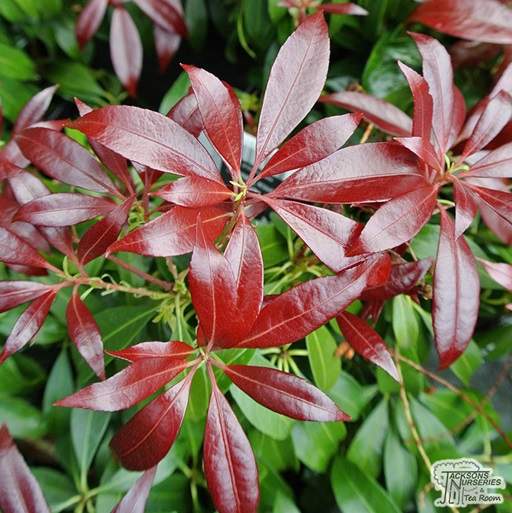
Perennials for Containers
- Agapanthus africanus - The unique shape and height of Agapanthus allow it to stand tall above many plant varieties allowing for verticle interest in a container or pot.
- Hosta fortunei var. albopicta – Shade-loving hostas are great for brightening up any containers or pots. Much loved by slugs, they are easier to protect when grown in a container.
- Lamium maculatum 'Beacon Silver' - Lamium maculatum ‘Beacon Silver’ creates a pretty mat of silver leaves and bright pink flowers in the spring. Good for dry, shaded areas.
- Lysimachia nummularia 'Aurea' - Lysimachia nummularia ‘Aurea’ reliably creeps and cascades over the edges of pots and containers, its golden leaves combining well with most other plants. Loves moist soil.
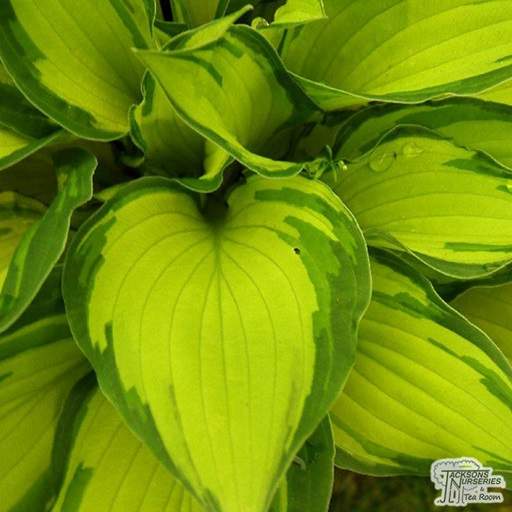
Climbers for Containers
- Clematis 'Nelly Moser' - This striking Clematis is an excellent choice due to its bright variegated flowers however, they are all excellent choices for containers as they prefer their roots to be kept cool. Combine with spring bulbs for extra impact.
- Hedera helix 'Goldheart' – Although many are rampant by nature, Ivys are an excellent choice for containers. They can either be left to cascade over the sides or allowed to clamber up nearby walls.
- Jasminum officinale – The highly scented flowers of Jasminum officinale make it an excellent choice for growing in a container near to doorways, entrances or walkways.
- Wisteria sinensis 'Prolific' - Wisteria are good choices for container grown climbers with their scented flowers and twining habit. They can even be trained into trees or wall cover.
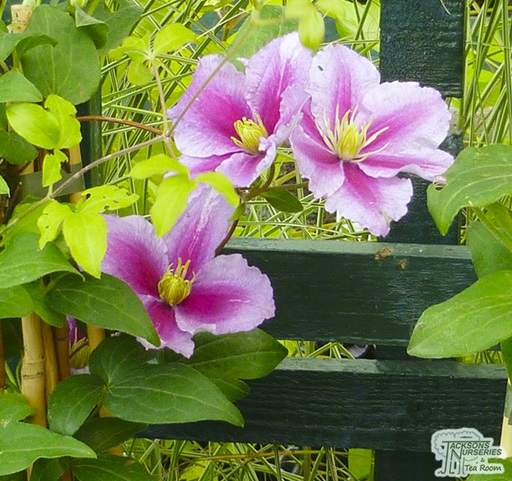
Grasses for Containers
- Carex oshimensis 'Evergold' – Bright yellow arching leaves with spikes of brown flowers, Carex oshimensis 'Evergold' adds height to a container and can cascade over the sides elegantly.
- Cordyline australis 'Salsa' – Its spiky leaves make Cordyline australis ‘Salsa’ an excellent choice for the centre of a planter or container. The bright pink leaves stand out from the crowd.
- Hakonechloa macra 'All Gold' – Forming mounds of golden leaves, Hakonechloa macra ‘All Gold’ makes an excellent statement container plant. Colours best in the morning sun.
- Yucca filamentosa – Striking, spiky, variegated leaves make Yuccas one of the best choices as a centrepiece plant for containers and planters.
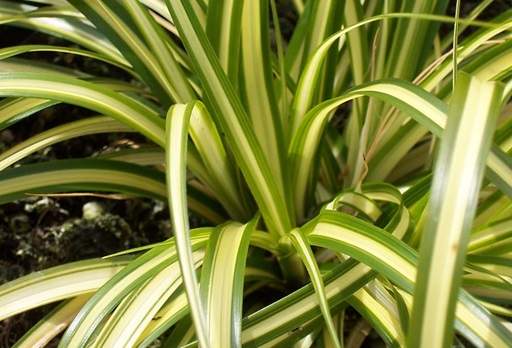
Conifers for Containers
- Chamaecyparis lawsoniana 'Minima Glauca' – The golden evergreen foliage of Chamaecyparis lawsoniana ‘Minima Aurea’ adds depth and colour throughout the year. Tightly packed foliage forms a rounded shape.
- Juniperus squamata 'Blue Star' – Slow, creeping Juniperus squamata ‘Blue Star’ is great for filling gaps in containers or pots. Allow it to cascade over the sides for added texture and interest.
- Picea glauca 'JW Daisy's White' – Dwarf evergreen conifer with a conical shape, Picea glauca ‘JW Daisy’s White’ has beautiful white young spring growth, brightening up any container or pot.
- Thuja occidentalis 'Smaragd' - A superb, columnar evergreen Thuja, emerald green in colour but with deep golden bronze tips, creating a golden glow.
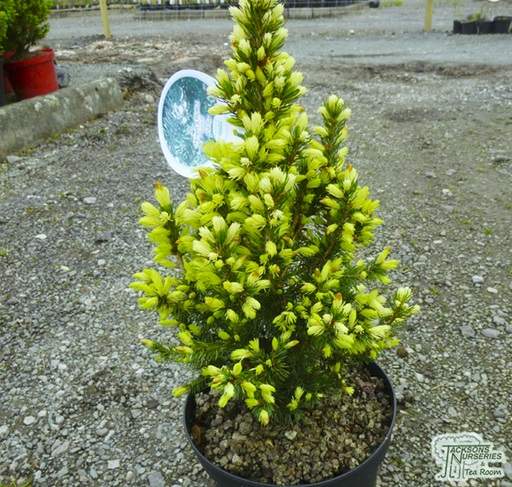
Trees for Containers
- Acer palmatum dissectum 'Garnet' – With their relatively slow growing speed and fantastic autumn foliage colours, Acer palmatum are ideally suited for growing in containers as a specimen plant. Huge range of colours to choose from.
- Prunus armeniaca 'Moorpark' – The most commonly grown Apricot in the UK, ‘Moorpark’ is tough, self-fertile, reliable and suitable for keeping in a pot in a sunny, sheltered position.
- Davidia involucrata – Ideal for growing in large pots, Davidia involucrate has a multitude of features, such as dark purple branches, red berries and white flowers.
- Trachycarpus fortunei – A very striking palm tree with a sturdy trunk and an array of fan-shaped leaves Flowering and seeding freely, it's perfect for adding tropical flair to planting schemes.
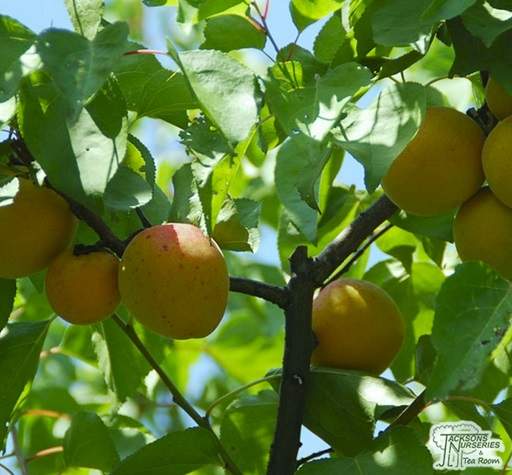
Share this page:

